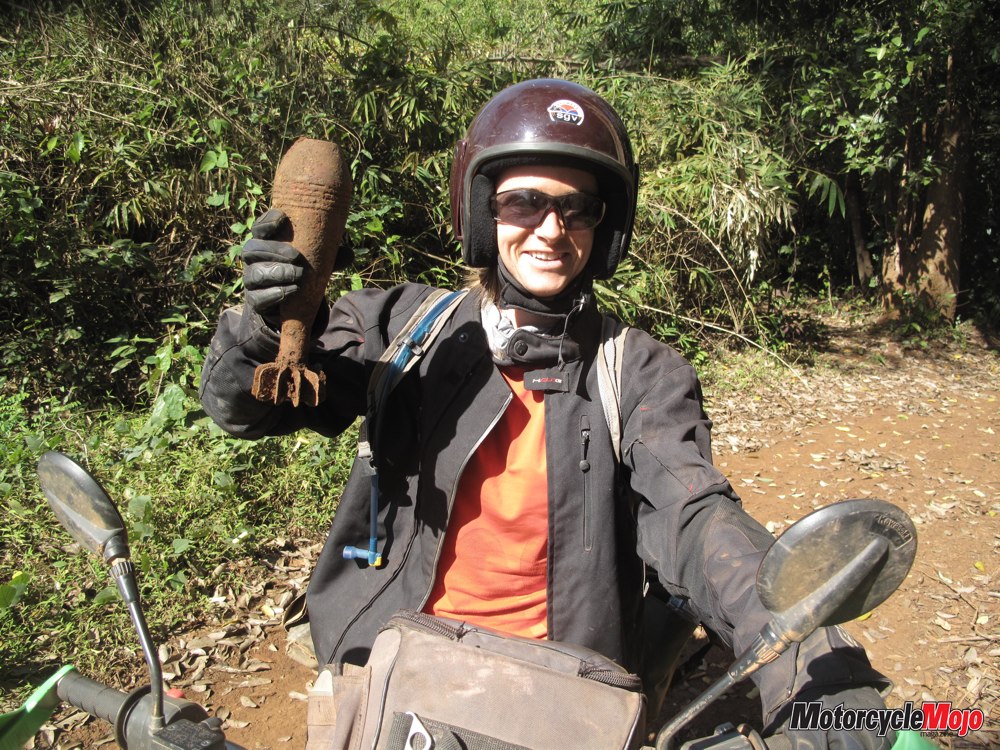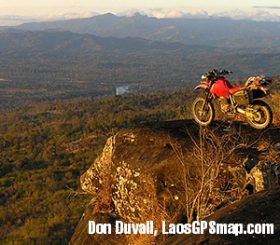Through bomb-cratered terrain, thick mud and dense jungle, a pair of riders and a pillion take on the near-impossible task of finding the real Ho Chi Minh Trail.
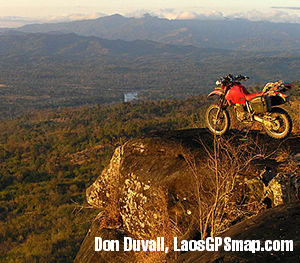 “You’ve got to ride a dirt bike like you’ve stolen it,” said Digby through gritted teeth, as he accelerated through a particularly gnarly section, the wheels weaving between rocks, mud spraying up from the bike in all directions. All around us was deep Southeast Asian jungle, with no form of civilization for miles. If anything happened to us out here, we were in big trouble; the only thing to do was to hold on and enjoy the ride.
“You’ve got to ride a dirt bike like you’ve stolen it,” said Digby through gritted teeth, as he accelerated through a particularly gnarly section, the wheels weaving between rocks, mud spraying up from the bike in all directions. All around us was deep Southeast Asian jungle, with no form of civilization for miles. If anything happened to us out here, we were in big trouble; the only thing to do was to hold on and enjoy the ride.
Less than a week before, I’d been sitting in an office in London, England, when my boss turned to me and asked, “How do you feel about a little trip to Laos next week?” A few days later, I was on a plane to Bangkok, bags hastily packed, a slight sense of trepidation as to what the hell I had let myself in for. My mission: to reconnoiter a 600 km section of the legendary Ho Chi Minh Trail for “The World’s Most Dangerous Roads,” a BBC TV program I was producing. And since the only two people who knew the Trail well enough to act as my guides were bikers, we’d be doing the trip in two-wheeled splendour.
My boyfriend, Marley, was less than delighted about my latest task. “So, let me get this straight; you’re going to be spending a week riding a motorbike through the jungle, with your thighs wrapped around another man? I’m not the jealous type, but . . .”
“Well, it is my job,” I’d replied weakly, before heading east.
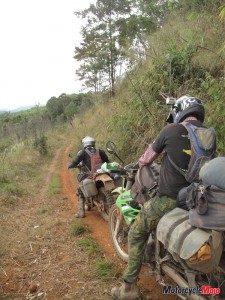 The “other man” was Digby Greenhalgh, the Australian head honcho of Hanoi-based motorbike tour company Explore Indochina, a bike and Trail obsessive. Digby has been exploring the Trail by bike for the last sixteen years, largely on old Soviet Minsks and Urals. This year alone, he’d led over fifteen bike tours through Vietnam and Laos: there was little about the Trail he didn’t know.
The “other man” was Digby Greenhalgh, the Australian head honcho of Hanoi-based motorbike tour company Explore Indochina, a bike and Trail obsessive. Digby has been exploring the Trail by bike for the last sixteen years, largely on old Soviet Minsks and Urals. This year alone, he’d led over fifteen bike tours through Vietnam and Laos: there was little about the Trail he didn’t know.
We’d be joined by Don Duvall, equally bike and Trail obsessed. Don, dubbed The Midnight Mapper, has lived in Laos for 10 years and dedicated these years to mapping every single square inch of the country by GPS from the back of his indefatigable Honda XR400. Duvall is 56 going on 20, and with a proclivity for frequent peals of laughter. His cartographic retentiveness knows no bounds; to date, he has mapped more than 50,000 GPS points in Laos. Don, who always rode solo, had only joined the ride at the very last minute and was a very welcome addition. “We’re very lucky to have Don,” said Digby, “If anything happened to us out there, with no phone reception and no help for miles, it wouldn’t be pretty.” At least with a third person, we had backup.
I couldn’t have wished for two better people to ride with.
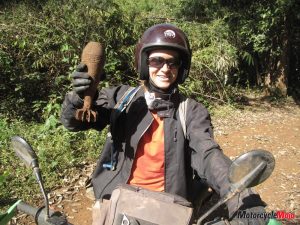 The Ho Chi Minh Trail is arguably one of the greatest feats of military engineering in history, a Goliath of ingenuity and bloody determination. At its peak, this 20,000 km transport network spread like a spider’s web through Vietnam, Laos and Cambodia, an indestructible labyrinth through which the North Vietnamese fed the war in the South. Without the Trail, there could have been no war, a fact that the Americans knew only too well. In a sustained, eight-year campaign to destroy it, they flew 580,000 bombing missions, dropped over 2 million tonnes of ordnance on neutral Laos, denuded the jungle with chemicals, and seeded clouds to induce rain and floods. At one point, Nixon even mooted the notion of deploying nuclear weapons.
The Ho Chi Minh Trail is arguably one of the greatest feats of military engineering in history, a Goliath of ingenuity and bloody determination. At its peak, this 20,000 km transport network spread like a spider’s web through Vietnam, Laos and Cambodia, an indestructible labyrinth through which the North Vietnamese fed the war in the South. Without the Trail, there could have been no war, a fact that the Americans knew only too well. In a sustained, eight-year campaign to destroy it, they flew 580,000 bombing missions, dropped over 2 million tonnes of ordnance on neutral Laos, denuded the jungle with chemicals, and seeded clouds to induce rain and floods. At one point, Nixon even mooted the notion of deploying nuclear weapons.
Amazingly, considering its importance, there are very few people today who know the whereabouts of the remaining sections of Trail. Backpackers may travel a sanitized, tourist version of the Ho Chi Minh Trail in Vietnam, but only a smattering of devotees make it as far as the real Trail in Laos, and many of these are bikers. In the 37 years since the war ended, much of the vast network of roads and tracks has simply been lost forever to the jungle, and most sections that do remain are heavily contaminated by unexploded ordnance (UXO). Even today, almost 40 years after the last bomb was dropped, UXO remains a deadly legacy of the war, killing around 200 people a year. Since our ride would be following some of the main arteries of the Trail, UXO was something we had to be very careful of – there would be no diving off into the jungle for a pee.
The three of us set off from the village of Nongchan, a scrappy border settlement in the shadow of the Truong Son Mountains. This jungle-clad spine of limestone peaks stretches for about 1000 km along the Vietnam-Laos border, and would be our companion for much of the ride south. Since I’d never ridden a dirtbike before, and now wasn’t the time to start, I’d be riding pillion with Digby on a Kawasaki KLX250 we’d hired from the capital, Vientiane, with Don riding solo on his Honda. Although Digby was a Trail veteran, this would be the first time he had ever attempted this section with a pillion, and neither of us knew whether it was feasible. Our Kawasaki’s dry weight was 138 kg, but with Digby, our luggage and me, it was carrying around 160 kg. In deep mud and rough tracks, this was going to be a challenge, to say the least. As I poured myself into the non-existent gap between Digby and our tower of luggage, Don let out a whoop of laughter. “Jeeeesus, you two are going to have an interesting time – this ride is hard enough solo, let alone with two of you on that bike.” By the time I’d wedged myself in, there was barely room for a bamboo sprout between us. Nongchan’s wooden shacks petered out into lush jungle, the morning mist hanging over jagged limestone outcrops, the red dirt road a mire of mud from recent rain. Bomb craters punctuated the roadside, a reminder that during the war, this area, the Ban Phanop valley, had been pummelled into oblivion by U.S. bombers. Forced through a natural gap in the mountains from Vietnam, all southbound traffic on the Trail was funnelled through this valley, a fact the Americans knew only too well. It was so heavily bombed that one U.S. pilot called it “the most Godforsaken place on earth.” Looking at the dense, verdant jungle that flanked us as we rode, it was hard to imagine that forty years ago, it would have looked like the surface of the moon. The first village we came to was a single, dusty street of ramshackle, stilted houses.
A gaggle of excitable, raggedly dressed children crowded around the two bikes, curious as to the identity of these newly arrived aliens in their midst. For people who rarely, if ever, had seen foreigners before, the sight of Don clad in head-to-toe SixSixOne Robocop-like body armour must have been akin to ET walking into a bar in Prince Rupert and ordering a beer. But within seconds, Don was laughing with the village chief and had the ever-expanding horde of children giggling happily. The whole village was a living war museum, and as we wandered up the street, Digby pointed out the countless bits of war ephemera converted for use in everyday life. Spring onions sprouted in rusty cluster-bomb casings, women leaned against ladders made of aluminum fuel rods, boys paddled in canoes fashioned from fuel canisters, and a chicken nested in a missile nose cone. Outside a small wooden temple, the faded wing of a U.S. F-4 Phantom fighter jet leaned against a tree, children peering at us through a large hole in the metal. Walking past one house, we noticed two large, 500 lb. bombs lying under the steps. “I’m sure those are still live. Look, they’ve still got the fuses on,” said Digby, pointing to their shiny tips. No one seemed the remotest bit concerned though, and children’s bare feet ran past inches from the fuses. We later found out from a non-governmental organization that these two bombs were indeed live, and that the man who had found them was keeping them until he could sell them for scrap metal. It highlighted what terrible risks people here would take with UXO in order to sell the valuable scrap metal and put food on their family’s table. Laos is a country of a thousand rivers, and as we rode south through Khammouane, Savannakhét, Saravan, Sékong, Attapeu and Champassak provinces, we would cross what felt like a hundred of these. Methods of getting across these rivers varied according to depth, width and how many people were watching. Generally, it was a case of throttle-on-feet-up-and-ride, hoping we wouldn’t smack a large rock in the middle and get a humiliating dunking. Deeper crossings saw me being hoofed off, while Digby edged the bike across and I walked. If we were lucky, there might be some sort of makeshift “bridge” – a questionably stable structure made of bamboo or galvanized metal.
One river crossing was somewhat more perilous. This particular river was several hundred metres wide, and while trucks could just about drive, bikes had to make the short journey on an extremely narrow, very unstable wooden canoe, steered by a toothless old man wielding a single pole. Digby rode the bike on in front of me, the wheels wedged in the rut at the bottom of the canoe, his legs resting on the paper-thin sides for stability. “Just crouch down, sit behind me and don’t move,” he said, not even daring to turn his head for fear of tipping us. I obeyed, hardly daring to breathe as the old man inched us across, so slowly that a large green lizard paddled past, eyeing us with a beady yellow eye. At one point we wobbled so violently I feared we’d be joining the lizard, and I could see Digby’s legs shaking with nerves. Once we reached the safety of the far bank, we both laughed hysterically, watching as Don did the crossing with infuriating ease and gusto. Tired, muddy, elated and in need of a Beerlao, we rolled into Villabury at the end of the first day, 120 km on the clock. “You’re going to love tonight,” Digby had said earlier, a glint of mischief in his eyes. “We’re staying at a tranny hotel.” I had visions of rolling up at a one-horse town in the jungle and finding a sequin-clad oasis of dancing ladyboys.
Instead, we were greeted by a rather corpulent, grumpy transvestite, whose short skirt revealed a pair of startlingly hairy legs. It was certainly a novel situation, and the $8 rooms, cheap beer and fried rice were just what we needed. The real crux of our ride was a 60 km section between Nong and Ta Oy, “the boonies” as the boys called it – dense jungle inhabited by remote tribes, elephants and the odd tiger. “No one’s ever ridden this section two-up” warned Digby, as we filled up at a fuel shack in Nong, where part of a tank languished outside. “I’m not even sure it’s possible.” After a few days on the road, our KLX was already feeling the strain – its pannier rack was cracked and the chain was sporadically jamming due to all the mud and dust. Don’s XR400, carrying around 80 kg less weight, was coping distinctly better. The ride was every bit as hard as Digby and Don had warned, a thrilling cocktail of river crossings, mud, rocks and steep hills, the tree canopy enveloping the track in a green womb. Only one hill managed to get the better of us, the bike sliding over in the mud, caking us both in a sticky layer of Trail dirt. Luckily, we were both fine, despite the absence of full body armour. Given the difficulty of the ride, Digby’s ability to handle the bike and steer us both through the jungle was remarkable. At times, slopes were so steep I had to get off and walk, but generally Digby would just yell at me to hold on, and we’d somehow make it through. Some of these sections were such a struggle I could feel Digby let out a huge breath of relief at the end, normally accompanied by a wild laugh. I can’t imagine a tougher or more exhilarating ride.
The few villages we did ride through in this area were home to some of Laos’s fifty different ethnic groups – animists who speak no Lao and have few ties with the central government. Pot-bellied pigs, skinny dogs and chickens scrapped in the dust, and no one seemed to be doing much. It was as if achievement was measured by who could do as little as possible, for as long as possible, in as much shade as possible. There were no schools, no temples, no electricity, and by the looks of the swollen stomachs of many of the children who ran after us, not enough food. It was so remote here we didn’t even pass the ubiquitous, overloaded mopeds, which frequently trundled past us during the rest of our ride, weighed down by anything from bananas to saucepans, logs and even live pigs. The only traffic we saw on this section was a handful of women walking barefoot along the track, large bamboo tobacco bongs slung round their necks. Amazingly, two of them fled into the jungle in terror at the mere sight of us – evidence of the rarity of foreigners in these parts. At Ta Oy, aching and adrenalized, we checked in to the only “hotel” and celebrated our victory by getting utterly inebriated on lao-lao, a potent local moonshine that should only be imbibed in the absence of anything else. Since Ta Oy was, as Digby so eloquently put it, “a shithole,” and our hotel was a plywood, mosquito-infested dive, getting drunk was an exceptionally good idea. The accommodation may not have been high luxury, but one of the many wonderful things about this ride was our ever-evolving environment.
We breezed along sections of graded red dirt, spun through glutinous mud, sped along the occasional winding ribbon of tarmac and bumped over original Ho Chi Minh Trail cobblestones. And as we pushed south, the topography changed entirely, morphing from jungle to strange, pine-clad plateaus, reminiscent of Greece or Turkey. At Chavan, on a parched plateau used by the French as an airstrip in the Indochina War, we ate a picnic lunch in an old bomb crater, then spent an exhilarating few hours trailing Don’s bike through the pines, leaves eddying up behind his wheels. Later that day the land changed again, the beautiful Bolaven plateau rising to our right, Truong Son mountains to our left, blue sky and ochre dirt completing the picture. Dipping down towards Attapeu as dusk fell, we passed the rusting hulk of a tank, abandoned in some distant battle, every ounce of removable metal stripped from it for scrap. Our last stretch was 200 km of surprisingly smooth tarmac between Attapeu and Pakse, a final dash before I had to cross the border to Thailand and catch a flight home. The ride had been such a blast, and Digby and Don such excellent companions, I wasn’t relishing the thought of being catapulted back to the normality of an English winter. With barely a moment to spare before I had to leave for the airport, we skidded into Pakse, a backpacker haunt on the Mekong River, and after a hasty goodbye to the boys, it was all over. Much to the disgust of my neighbour on the long flight home, I hadn’t even had time to wash or change, and travelled the whole way to England covered in a thick layer of Trail mud. It was a strangely satisfying end to a truly marvellous adventure.









